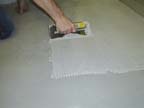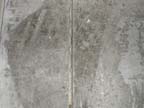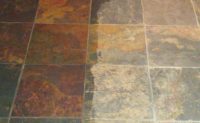
It isn't easy to separate fact from fiction when considering crack-isolation systems. Because these systems are available in differing formats and used in a wide variety of installations, many misperceptions exist about how crack-isolation systems work, what they do and don't do, and what they cost.
The best way to begin separating fact from fallacy is to go “back to school†to get up to speed on crack-isolation technology and stone tile installation practices. This will ultimately help improve the bottom line.

A brief review
First, let's take a quick refresher on how crack-isolation systems work and why they are needed.Cracks naturally occur in concrete flooring substrates as the water in the concrete gradually evaporates. These cracks, called shrinkage cracks, can occur randomly throughout the substrate. Potential problems emerge when rigid stone tile is bonded to the concrete because the cracks can migrate from the substrate to the tile. When that happens, the installed tile can be damaged, resulting in expensive repairs.
The solution is to isolate the substrate from the tile. This prevents the shrinkage cracks from transferring upward to the tile flooring.
A crack-isolation quiz
So, what do you know about crack isolation? Test yourself with this quiz. Most answers are true or false.Statement: There are two types of crack-isolation formats -- one-step mortars and sheet membrane systems.
False. Crack-isolation systems are available in several formats. Membrane formats include sheeting materials (such as polyvinyl) as well as liquids and trowel-applied membranes. Some sheeting materials have a peel-and-stick adhesive that allows them to be applied directly to the substrate. These materials are then topped with mortar to set the tile. Other sheet membrane systems require an initial layer of mortar to be applied to the substrate. Then, the sheeting follows. A final layer of mortar is applied to set the tile. Liquid and trowel-applied membranes are placed directly on the substrate and topped by a mortar to set the tile. Some liquid membranes also incorporate a fiber mat.
One-step crack-isolation mortars are formulated with polymer additives. This type of mortar isolates shrinkage cracks and allows tile to be set in a single step.
Statement: If there aren't cracks already in the substrate, there are no worries.
False. Cracks can and will come back to haunt you -- especially when the concrete substrate is relatively new. Shrinkage cracks develop as the concrete substrate dries. In fact, an estimated 80% of shrinkage cracks occur within the first year after the substrate is poured.
Statement: The slip-sheet, crack-isolation method is outdated and a bad idea.
True. The practice of applying an adhesive paper slip-sheet directly to the substrate and then covering it with mortar to set the tile is inexpensive, but problem-prone. Cracks can still transfer through the paper and mortar to the tile. Worse, the paper can lose its bond to the substrate, resulting in loose tiles that must be reset. In addition, paper deteriorates when subjected to moisture.
Statement: A membrane crack-isolation system provides the best protection.
A trick question. It depends on the type of stone tile installation. The installation might involve a wet area, a newly poured concrete substrate or might not have any special considerations.
If the installation is in a wet area, such as a shower, some crack-isolation membrane systems provide water-proofing protection for the substrate as well as crack isolation protection, as the name implies. Be aware that some crack-isolation membranes must be applied in a specific manner to be considered waterproof.
If a project deadline requires installation over new concrete -- also called “green concrete†-- some liquid crack-isolation membranes can do the trick. These products are formulated to accommodate the stress to the tile's bond that occurs as moisture evaporates from the substrate. This feature allows tile to be installed over concrete that is just three days old compared with the normal wait of 28 days.
If an installation does not involve a need for waterproofing or a green concrete substrate, the choice will be a membrane or one-step mortar system. The answer will be clear when key factors, such as labor and material costs, are considered.
Statement: One-step crack-isolation mortars are expensive.
Another trick question. A one-step crack-isolation mortar is often a cost-effective option when efficiency is factored into the equation. Because this approach combines crack isolation and tile setting in one step, labor costs are reduced. It also eliminates the additional materials when sheet membrane or some liquid membrane crack-isolation systems are used.
Statement: Materials and labor are the primary costs to consider when choosing a crack-isolation system.
False. You should also factor in opportunity cost, which involves the ability to finish projects sooner and move on to other opportunities with confidence.
For example, take a contractor who typically completes one installation per week using a crack-isolation system that requires multiple steps. But by choosing a one-step crack- isolation system, this same contractor could potentially complete an additional installation each week. The time the contractor saves through the increased productivity translates into greater income. In short, time is money.
Statement: Crack-isolation systems are just another way for manufacturers and suppliers to make money.
False. Failure to isolate cracks can be costly when cracked tile flooring requires removal and re-installation. And, don't forget that matching tile and stone from different lots can be a serious challenge. In addition, the trend is toward increasingly larger stone tile sizes, such as 16 x 16 or 24 x 24 inches. Bigger tile can be generally more susceptible to cracking with an untreated substrate.
Statement: A crack-isolation system can bridge any crack or joint.
False. This has to do with the term “bridging,†and the definition for various types of cracks and joints.
“Bridging†refers to filling an existing crack or joint with a setting material to create a bridge over the crack or joint. While many materials will fill a crack, what's important in a crack-isolation system is the system's ability to withstand the movement in the crack. That is what prevents the crack in the substrate from transferring to the tile. In other words, don't be lulled into a false sense of security with a system that claims to “bridge†cracks.
Regarding cracks, there are different types. Shrinkage cracks, which are usually 1â„16 to 1â„8 inch and naturally occur in concrete substrate, can be successfully isolated by crack-isolation systems. Structural cracks, meanwhile, are caused by structural defects in the substrate. Crack-isolation systems of any kind won't prevent structural cracks from damaging the installed tile.
There are also different types of joints. Builders typically place contraction joints, also called control joints, in the substrate to channel shrinkage cracks. (Keep in mind that some builders might not do this, which increases the need for crack isolation.) Contraction joints can be isolated from tile by some crack-isolation systems. Another joint type is the expansion joint, or isolation joint. These joints are designed to move with the substrate. They cannot be isolated by crack-isolation systems. In fact, attempting to bridge expansion joints will often result in cracked tile and is not recommended.
Statement: A crack-isolation system's bond strength and flexibility are good predictors of performance.
True. A crack-isolation system must balance bond strength and flexibility. The trick is to find one that offers both. A premium crack-isolation mortar, for example, will have bond strength of 375 to 475 psi with quarry tile to cured concrete and enough polymer content providing the flexibility to protect against cracking of up to 1â„8 inch.
One sure guideline when searching for a solution is the American Society for Testing and Materials (ASTM) C627 Robinson Floor Test. It measures an installation's performance over time under a continuous traffic load and assigns a foot-traffic rating. A premium crack-isolation mortar will carry a rating of “Residential†to “Heavy,†depending on the substrate.
Statement: The challenge with crack-isolation systems is the 24-hour wait before you can grout.
False. Some advanced crack-isolation mortars are uniquely formulated to crack isolate, yet allow for the application of grout within four hours of setting tile. This is especially important when contractors are under pressure to finish jobs as quickly as possible because it speeds up the crack isolation, tile setting and grouting processes.
Statement: Warranties and guarantees are virtually the same.
False. Some crack-isolation system warranties only cover manufacturing defects. In these warranties, the manufacturer will provide a replacement product to resolve the problem. Labor
is not included. Other manufacturers offer performance warranties, which guarantee crack specific protection (such as up to 1â„8 inch) for a specified number of years. Under these warranties, the manufacturer agrees to not only replace the defective material, but to also redo the tile installation.
